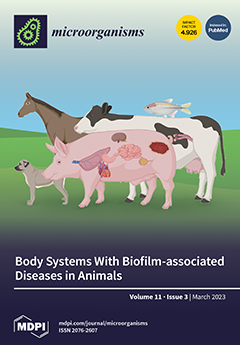Vibrio anguillarum is the most frequent pathogen affecting fish worldwide. The only known virulent strains of
V. anguillarum are serotypes O1, O2, and O3. Genetic differences between the serotypes that could shed insight on the evolution and serotype differences of this marine pathogen
[...] Read more.
Vibrio anguillarum is the most frequent pathogen affecting fish worldwide. The only known virulent strains of
V. anguillarum are serotypes O1, O2, and O3. Genetic differences between the serotypes that could shed insight on the evolution and serotype differences of this marine pathogen are unknown. Here, we fully sequenced and characterized a strain of
V. anguillarum O1 (J382) isolated from winter steelhead trout (
Oncorhynchus mykiss irideus) in British Columbia, Canada. Koch’s postulates using the O1 strain were replicated in naïve lumpfish (
Cyclopterus lumpus) and compared to O2. Phenotypic and genotypic comparisons were conducted for serotypes O1, O2, and O3, using biochemical tests and bioinformatic tools, respectively. The genome of
V. anguillarum O1 (J382) contains two chromosomes (3.13 Mb and 1.03 Mb) and two typical pJM1-like plasmids (65,573 and 76,959 bp). Furthermore,
V. anguillarum O1 (J382) displayed resistance to colistin sulphate, which differs from serotype O2 and could be attributed to the presence of the
ugd gene. Comparative genomic analysis, among the serotypes, showed that intra-species evolution is driven by insertion sequences, bacteriophages, and a different repertoire of putative ncRNAs. Genetic heterogeneity in the O-antigen biosynthesis gene cluster is characterized by the absence or the presence of unique genes, which could result in differences in the immune evasion mechanisms employed by the respective serotypes. This study contributes to understanding the genetic differences among
V. anguillarum serovars and their evolution.
Full article






